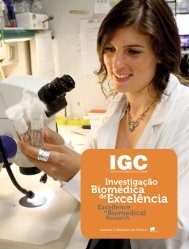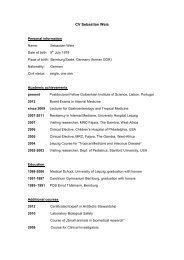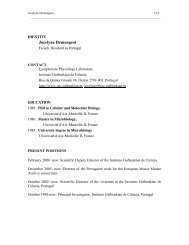organisation - the Instituto Gulbenkian de Ciência
organisation - the Instituto Gulbenkian de Ciência
organisation - the Instituto Gulbenkian de Ciência
- No tags were found...
Create successful ePaper yourself
Turn your PDF publications into a flip-book with our unique Google optimized e-Paper software.
MOLECULAR<br />
NEUROBIOLOGY<br />
Diogo S. Castro Principal Investigator<br />
PhD in Cell and Molecular Biology, Karolinska Institute, 2001<br />
Post doctoral fellow, MRC National Institute for Medical Research, London, UK<br />
Senior Investigator Scientist, MRC National Institute for Medical Research, London, UK<br />
Principal Investigator at <strong>the</strong> IGC since 2010<br />
The assembly of a functional nervous system <strong>de</strong>pends on <strong>the</strong> coordinated<br />
generation of neurons and glia cells from multipotent neural stem cells in <strong>the</strong><br />
<strong>de</strong>veloping embryo. The progression of this differentiation process is associated<br />
and controlled by changes in gene expression programmes that need to<br />
be very tightly regulated. For <strong>the</strong> moment we are mostly interested in un<strong>de</strong>rstanding<br />
<strong>the</strong> role played by various transcription factors, with a special focus<br />
on bHLH proneural proteins, in neurogenesis. We aim at characterising <strong>the</strong>ir<br />
transcriptional networks, as well as un<strong>de</strong>rstanding <strong>the</strong> molecular mechanisms by<br />
which such programmes are regulated, and how <strong>the</strong>y contribute to <strong>the</strong> acquisition<br />
of specific cellular phenotypes. In our work we take advantage of recently<br />
<strong>de</strong>veloped genomic approaches that allow <strong>the</strong> characterisation of transcriptional<br />
programmes at a genome wi<strong>de</strong> level, complemented with more classical<br />
methods to study gene expression, having <strong>the</strong> mouse embryo as a mo<strong>de</strong>l<br />
system.<br />
GROUP MEMBERS<br />
Alexandre Raposo (Post-doc, started in August 2011)<br />
Vera Teixeira (Post-doc, started in May 2011)<br />
Francisca Vasconcelos (PhD stu<strong>de</strong>nt)<br />
Pedro Rosmaninho (PhD stu<strong>de</strong>nt, started in April 2011)<br />
COLLABORATORS<br />
François Guillemot (MRC National Institute for Medical Research, London, UK)<br />
Stefan Momma (Johann Wolfgang Goe<strong>the</strong> University, Frankfurt, Germany)<br />
Deolinda Lima (Faculda<strong>de</strong> <strong>de</strong> Medicina da Universida<strong>de</strong> do Porto,Portugal)<br />
Vania Broccoli (San Raffaele Scientific Institute, Milan, Italy)<br />
Carlos Parras (Hôpital <strong>de</strong> la Pitié-Salpêtrière, Paris, France)<br />
FUNDING<br />
Fundação para a Ciência e a Tecnologia (FCT), Portugal<br />
<strong>Instituto</strong> <strong>Gulbenkian</strong> <strong>de</strong> Ciência (IGC), Portugal<br />
PUBLIC ENGAGEMENT IN SCIENCE<br />
Biology in Mo<strong>de</strong>rn Times seminars for teachers, IGC, April<br />
TRANSCRIPTIONAL CONTROL OF VERTEBRATE NEUROGENESIS<br />
BY THE PRONEURAL FACTOR MASH1<br />
Vertebrate neurogenesis is controlled, to a large extent, by basic helix-loophelix<br />
proneural factors such as Mash1 (aka Ascl1). The use of Mash1 in reprogramming<br />
protocols aiming at generating mature neurons from o<strong>the</strong>r cell types<br />
stresses <strong>the</strong> importance of un<strong>de</strong>rstanding <strong>the</strong> molecular mechanisms that un<strong>de</strong>rlie<br />
its activity. Recently, we have performed <strong>the</strong> first genome wi<strong>de</strong> characterisation<br />
of a neurogenic programme downstream of Mash1, by <strong>the</strong> large<br />
scale i<strong>de</strong>ntification of its transcriptional targets. Strikingly, our results showed<br />
that Mash1 directly controls both early (eg. cell fate commitment) and late (eg.<br />
neurite outgrowth) steps of neurogenesis. This project aims at investigating<br />
<strong>the</strong> epigenetic and transcriptional mechanisms that contribute to <strong>the</strong> temporal<br />
regulation of neurogenesis by Mash1, by analysing <strong>the</strong> role played by <strong>the</strong><br />
chromatin landscape and interactions with o<strong>the</strong>r transcriptional networks that<br />
operate in neural progenitors.<br />
We have i<strong>de</strong>ntified <strong>the</strong> zinc-finger transcription factor Myt1 as a direct target of<br />
Mash1 in a neurogenic context. A transcriptional synergy between <strong>the</strong> two factors<br />
in promoting differentiation suggests <strong>the</strong>y may <strong>de</strong>fine an important feedforward-loop<br />
at <strong>the</strong> onset of neurogenesis. The genome-wi<strong>de</strong> characterisation<br />
of Myt1 binding events in neural progenitors predict functional interactions with<br />
o<strong>the</strong>r important transcriptional regulators, currently being investigated.<br />
THE TRANSCRIPTIONAL NETWORK OF THE ZINC-FINGER FACTOR ZEB1<br />
AND ITS FUNCTION IN NEURAL STEM/PROGENITOR CELLS<br />
Current interest in neural stem cells <strong>de</strong>rives from <strong>the</strong> prospect of using <strong>the</strong>m<br />
in brain repair strategies, but also to un<strong>de</strong>rstand neuro<strong>de</strong>velopmental pathologies.<br />
This will require, however, a significant improvement of our un<strong>de</strong>rstanding<br />
of <strong>the</strong> gene expression programmes associated with <strong>the</strong>ir maintenance and differentiation,<br />
and how <strong>the</strong>se are regulated. Recently, several lines of evi<strong>de</strong>nce<br />
suggest a regulatory function for <strong>the</strong> zinc-finger transcription factor ZEB1, both<br />
in embryonic neural stem/progenitor cells, and in human tumours of neural<br />
origin. Here we propose to use a multidisciplinary approach, combining mouse<br />
genetics and genomics, to characterise <strong>the</strong> function of ZEB1 in neural <strong>de</strong>velopment.<br />
Moreover, a comparison of <strong>the</strong> ZEB1 transcriptional programmes in human<br />
foetal- and glioma-<strong>de</strong>rived stem cells will be carried out, providing important<br />
insights into ZEB1 function in tumour initiation and <strong>de</strong>velopment.<br />
We have begun to characterise <strong>the</strong> transcriptional programme downstream of<br />
Zeb1 in neural stem/progenitor cells, having performed its genome-wi<strong>de</strong> location<br />
analysis, by chromatin immunoprecipitation followed by <strong>de</strong>ep sequencing<br />
(ChIP-seq).<br />
HES6 PROMOTER.<br />
Genome-wi<strong>de</strong> location analysis by ChIP-seq shows binding of <strong>the</strong> transcription<br />
factors Mash1, Hes1 and Myt1 to <strong>the</strong> proximal promoter region of <strong>the</strong> neurogenic<br />
gene Hes6.<br />
IGC ANNUAL REPORT ‘11<br />
RESEARCH GROUPS<br />
30






